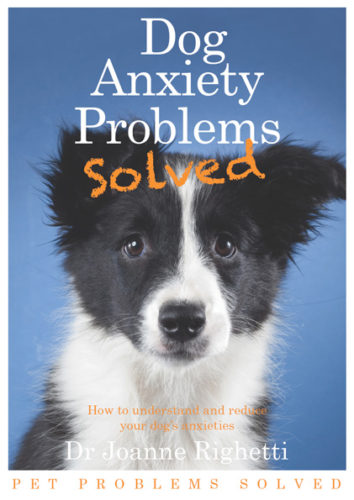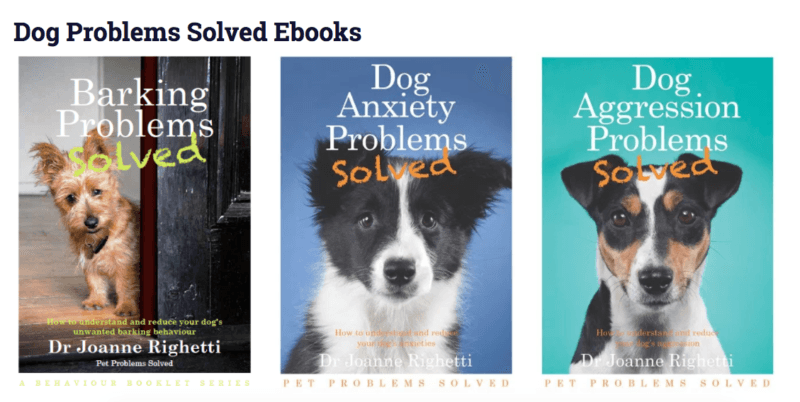Separation Anxiety in Pets and Separation Anxiety in Pet Owners Too!
Separation Anxiety Problems and their Solutions: Summary
- Separation anxiety is a problem in pets who dislike being left alone. Their anxiety results in unwanted behaviours such as barking, inappropriate toileting, escaping, hiding or destructive behaviour.
- Management of canine barking is important. Leaving your pet in a safe area with calming tools and a job to occupy them may help.
- Long term solutions involve letting your pet get used to being alone gradually and positively. Medications may help.
What is Separation Anxiety in Pets (and People)?
Separation anxiety, also known as separation-related distress, occurs when pets are overly bonded to their owners and then fret when left alone. Owners can feel guilty too and we see separation anxiety in pet owners too!
Separation anxiety is common in dogs but cats and some birds may suffer too. and pet owners can also feel anxiety at having to leave their pet alone.
Read more about:
Anxiety in dogs
Anxiety in cats
Symptoms of separation anxiety in pets
How do you know if your pet has separation anxiety?
Common symptoms of separation anxiety in dogs include:
- barking and whining
- escaping and roaming
- scratching at gates/doors
- inappropriate toileting behaviour
- chewing, digging and general destructive behaviour
Cats with separation-related issues will often display symptoms including sleeping, pacing, crying or toileting inappropriately. These cats may sleep more than normal or they may pace or cry near doorways where you have left. Anxious cats often toilet inappropriately around their home.
Pets who suffer from separation anxiety generally display these unwanted behaviours immediately after their owner’s departure. Some pets start to get anxious even before you leave. They have learned your patterns of behaviour and are anticipating your departure.
If your pet has separation anxiety, you will likely have seen evidence of some of the symptoms described above. Your neighbour may tell you that your dog barks soon after you leave home. You may find your lawn dug up.
if you are unsure but suspect your pet has separation anxiety, then you could sneak back to listen or watch your pet, where they cannot see you. Or you could erect a video camera and spy on your pet when they are alone.
Timing of Separation Anxiety in Pets
Most cases of separation anxiety in pets occur within 30 minutes of you leaving home. In fact, most are within a few minutes of you leaving.
Some will even display symptoms of anxiety prior to you leaving. they are so aware of your routines that they know by the shoes you wear or the timing of your morning shower or breakfast, that you are going to leave them and they start to get anxious.
If you see the described symptoms but only after our pet has been alone for hours, it is more likely to be boredom causing the behaviour issues.

How to Solve Separation Anxiety in Pets
Solving a behaviour problem is always a matter of:
- Management of the issue
- Long term solutions
Read more about behaviour modification here.
Tips for relieving separation anxiety in pets
These tips will help you manage separation anxiety in pets and work towards a long-term reduction. Try as many of the following as possible:
- Leave calming music e.g classical/reggae and lavender scents (dogs only) or try Adaptil or Feliway, pet appeasing pheromones.
- Change your routines around. This may help your pet respond less stressfully from the moment you wake up.
- Try to remain calm, when you are preparing to leave home and also when you return home to your pet. Keeping calm yourself may help your pet stay calm.
- Hire a pet sitter, dog walker or use a pet day care.
- Create den-like areas for your pets; a crate for your dog, a box for your cat. Smaller areas make many pets feel more secure.
- Leave your pet with an object that has your scent on it; a blanket or an old sweater.
- Leave your pet with something to occupy them for the first 30 minutes of being alone.
Gradual Separations from your pet
It is useful for owners to teach their pet to accept being alone. These suggestions may help your pet learn to cope with being alone.
- Start to leave your pet alone for short periods. Separate from your dog, while you are at home. Leave the room, giving your pet the chance to be alone. Gradually build up the periods of time that your dog is alone. Start at 30secs, if this is all your pet can cope with, and gradually build up to 30mins or more.
- Respond to your pet when they are quiet. Responding to unwanted behaviour will only reinforce that particular behaviour. Ignore unwanted behaviour and reward the “good”.
- Leave your pet with a ‘job’ to do – a toy or some treats to find will keep them occupied for a short time (more time-consuming treats for longer times). This may need to be your pet’s favourite snack, as it needs to be very motivating. Do not give this at other times.
Medication for separation issues
Some pets are so stressed that they may need anti-anxiety medication in addition to behavioural therapy for the best behavioural success. Talk to your vet about medication.
Frequently asked questions about separation anxiety in pets
Will my dog always have separation anxiety?
If you work on the issue, your dog should overcome the dreaded separations. Your dog may be prone to anxiety returning, especially after prolonged time period together e.g. after holidays.
Will my puppy grow out of separation anxiety?
Some dogs may get better naturally but most need some help, using gradual separations and all the tips given above.
Will Adaptil help with my dog’s separation issues?
Teh dog appeasing pheromone, Adaptil, will help with separation anxiety but works best when paired with behavioural therapy.
Tips for understanding and solving separation anxiety in dogs, with Dr Jo Righetti (and Chilli dog)
Coping with Separation Anxiety in Pet Owners
If you hate leaving your pet alone, here are some tips to help you cope:
- Use the tips above to help your pet who suffers from separation anxiety, if they also suffer from separation anxiety. If you know they are calm, it will help you remain calm.
- Spend quality time with your pet when you can. Knowing that you have given them engaging activities with you, will help them relax when alone and you relax too.
- Give your pet things to do, especially when you just leave home. Then you know they’ll be occupied. Also have something to occupy your thoughts for the first hour of being away from your pet.
- Use a camera to watch your pet. Set it up where your pet is likely to spend their time. Seeing how calm your pet is, should help you relax.
- Speak to your doctor about other ways of remaining calm. Anti-anxiety medication, natural remedies and behaviour therapies may help you cope with your anxiety.
Do you ever wonder if your dog misses you when you are gone?
Dogs are our faithful, furry friends. Such adoring, unconditional support can be hard to find in a human friend or family member. Perhaps due to this mutual adoration, many dog owners feel guilty at leaving their dog behind when they go on holiday. But do dogs miss us?
Should we worry? Do dogs really miss us? Well this may vary with our dog’s personality.

Doggy devotion
Some dogs are so overly bonded to their owners that they fret when left alone. Pacing, barking, trying to escape, inappropriate toileting and destructiveness are all common symptoms of separation anxiety in dogs.
This condition can be difficult for both owner and dog to cope with. Anxious dogs often react within minutes of the owner leaving home, sometimes even before their owners have departed. These distressed doggies certainly miss us – too much!
Enthusiastic tail-waggers
But what about dogs who are more chilled out at home, and simply snooze the time alone away or perhaps chew their toys, happy in their solitude? Do these dogs miss us?
Well most of these relaxed pooches love to welcome us home again, after a departure. We can receive a delightful greeting even when we’ve only made the short trip to the garbage bin!
Dogs greet us with similar behaviours, no matter how much of the day we have been gone. This generally involves lots of physical activity, tail wagging, interactions with owners and attentive behaviour. The intensity of their greeting, however, may differ depending on the amount of time they have been alone. When left alone for 4 hours, dogs react more than when left alone for 30 minutes or even for 2 hours. The longer time apart, the more intense the greeting.
After the longer time apart, dogs also showed more lip licking and body shaking, perhaps indicating a tinge of anxiety. Having other people present and activities to occupy them may help dogs pass their time without you.
Cool canines
Some owners worry when they return after a holiday of several days or weeks and their dog appears to be less than enthusiastic. Do these dogs miss us at all?!
Providing your dog is in good physical health, this is generally not something to worry about. Your dog may be reacting to the unusual scents and objects (holiday souvenirs) around your home. Plus, in their doggy minds, they are ensuring that they are still welcome when re-entering the social group. These quieter dogs quickly readjust and return to normal.
Peace of mind?
For those overly anxious canines, reduce their separation-related distress (read above tips) requires by short separations, gradually building up time, making separations as positive as possible. In severe cases of anxiety, dogs may require medication to enable them to reduce stress levels. If you are planning on leaving your overly-bonded dog at home while you holiday, it’s best to start working on this issue months before your departure. Or ensure that your dog stays with someone who understands their devotion.
For the majority of dogs, however, they will settle in nicely to their minder’s household, especially if they have made friends already. Your dog may even enjoy the variety of new activities they experience. If you are comfortable with the environment and carers that you are leaving your dog with, your can relax and enjoy your break.
And, even if dogs miss us, you don’t have to worry that your dog will forget you. You can be sure of an enthusiastic greeting on your return!
More about pet anxiety
Dog Anxiety Problems Solved
Dogs suffer from anxiety, fears and phobias quite commonly. Understanding your dog’s stressors, managing their behaviour and finding a long-term solution is important.
Separation anxiety in pets is covered in this book.
Read these tips on understanding dog anxiety. Or take a look at Dr Jo Righetti’s ebook Dog Anxiety Problems Solved.
Now available at Amazon.

More about anxiety and other pet behaviours
- Chilli Dog And Bush Turkey Go for a Walk!Chilli Dog and Bush Turkey go for a Walk! This is the story and Chilli dog and a Bush Turkey!Right now, December, in Australia’s Brush Turkey
- Do Cats and Dogs like to Look at Us?Do cats and dogs like to look at us? We like to look into the faces of our pets but do cats and dogs like to
- Does my cat love me? 7 Signs of cat love and affectionDoes My Cat Love Me? 7 Signs of Cat Love and Affection “Does my cat love me?” A question every cat owner asks at times! Dr
- Cats and litter: 7 Cat Litter Box RulesCats and litter: 7 Cat Litter Box Rules and the Best Cat Litter What type of cat litter does your cat prefer to use? What about
- Predicting the behaviour of rescue dogs. New Research to Improve AdoptabilityPredicting the behaviour of rescue dogs : It’s difficult to compare a shelter to a sofa! Are you thinking about adopting a rescue dog from a
- A dog’s environment impacts their communication behavioursA dog’s environment impacts their communication behaviours New research has confirmed that a dog’s environment impacts their communication behaviours. Dogs generally matched the enthusiasm of their
- Top 10 Problem Pets – and Problem Pet BehaviourAre you frustrated, angry or puzzled y your pet’s behaviour? Here’s your guide to the top 10 problem pets and problem cat behaviour and dog behaviour…
- Road tripping with a dog with car anxietyIf your dog is anxious while you travel, these tips, from Sarah Archer at Your Best Digs, may help… Road tripping with a dog with car
- Ask Dr Jo – Your Cat Q&As (With adorable Cats to watch!)Ask Dr Jo – Your Cat Q&As in the Fancy Feast Lounge Enjoy our cat videos, and get your feline questions answered, in my series of
- 4 Signs that your cat is a flirt?4 Signs that your cat is a flirt Is your cat a flirt? Do they try to get your attention any way they can? Cats are
About the author of pet behaviour articles: Dr Jo Righetti
Dr Jo Righetti is an animal behaviourist, helping people with pets. With a PhD in behaviour, a diploma in counselling and over 20 years experience in business Pet Problems Solved, Dr Jo understand pets and communicates here knowledge in a motivational manner.





